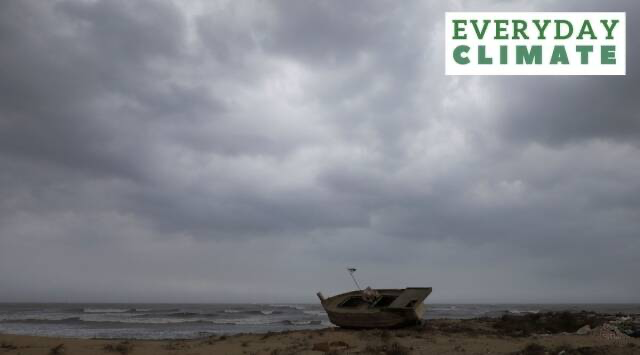Description

Disclaimer: Copyright infringement not intended.
Context: Landfall of Cyclone Biparjoy in the state of Gujarat.
Details
Cyclone Biparjoy and Landfall:
- Cyclone Biparjoy made landfall near Jakhau port in Gujarat's Kutch district.
- Landfall refers to a tropical cyclone reaching the coast after being over water.
- It signifies the movement of the storm's center or eye over the land.
Difference between Landfall and Direct Hit:
- Landfall: Center of the storm moves over the coast.
- Direct Hit: Core of high winds (eyewall) comes onshore, but the center of the storm remains offshore.
- Strongest winds in a cyclone may be experienced over land even without a landfall.
Impact of Cyclone's Landfall:
- Damage depends on the cyclone's severity, primarily determined by wind speed.
- Cyclone Biparjoy is classified as a "very severe cyclonic storm."
- Potential damages include extensive damage to kutcha houses, disruption of power and communication, minor disruption of transportation, threat from flying debris, and flooding of escape routes.
- Factors contributing to damage are strong winds, heavy rainfall, and storm surges causing coastal floods.
Duration of Landfall:
- Landfalls typically last a few hours, depending on wind speed and storm size.
- Cyclone Biparjoy's landfall is expected to last around five to six hours.
- After landfall, the cyclone's intensity gradually decreases over the next 24 hours due to reduced moisture supply and increased surface friction.
Consequences of Landfall:
- Landfalls are often the most devastating moments of cyclones.
- They mark the beginning of the cyclone's weakening and eventual dissipation.
- As the cyclone moves over land, its impact diminishes, leading to a reduction in intensity.

About Cyclones
- A cyclone is a large-scale weather system characterized by low atmospheric pressure at its center and rotating winds.
- Cyclones can form over both land and water, but they are most commonly associated with tropical regions.
- They are also known by various names depending on the region, such as hurricanes, typhoons, or tropical cyclones.
Cyclone Classification:
- Cyclones are classified based on their wind speed and intensity.
- The Saffir-Simpson Hurricane Wind Scale is commonly used to categorize cyclones, ranging from Category 1 (weakest) to Category 5 (strongest).
- The classification helps predict the potential damage and preparedness measures required.
Formation and Life Cycle of Cyclones:
- Cyclones develop from tropical disturbances, which are areas of low pressure with organized thunderstorm activity.
- Warm ocean temperatures, moisture, and low wind shear provide favorable conditions for cyclone formation.
- The lifecycle of a cyclone includes stages such as tropical depression, tropical storm, and finally, a mature cyclone.
Impact and Destructive Elements:
- Strong Winds: Cyclones are characterized by powerful winds rotating around the center, known as the eye.
- Heavy Rainfall: Cyclones bring heavy precipitation, leading to extensive flooding and potential landslides.
- Storm Surge: The low pressure at the center of a cyclone causes a rise in sea level, resulting in a storm surge that can inundate coastal areas.
Tracking and Forecasting Cyclones:
- Meteorological agencies use advanced technologies, including satellites, radar, and computer models, to track and forecast cyclones.
- Early warning systems are crucial to providing sufficient time for evacuation and emergency preparedness.
Mitigation and Preparedness:
- Governments and disaster management agencies undertake measures to mitigate the impact of cyclones, including building cyclone shelters, implementing evacuation plans, and disseminating timely warnings.
- Public awareness campaigns educate communities about preparedness measures, such as securing property, stocking essential supplies, and heeding evacuation orders.
Environmental Significance:
- While cyclones bring destruction, they also play a vital role in maintaining the Earth's heat balance and redistributing heat from the tropics to higher latitudes.
- Cyclones contribute to the replenishment of water resources and are essential for ecological processes in coastal ecosystems.
|
PRACTICE QUESTION
Q) Which of the following statements about cyclones is correct?
A) Cyclones are weather systems characterized by high atmospheric pressure at their center.
B) Cyclones are most commonly associated with polar regions.
C) The Saffir-Simpson Hurricane Wind Scale is used to classify cyclones based on their rainfall intensity.
D) Cyclones form from tropical disturbances and undergo stages such as tropical depression and tropical storm before becoming a mature cyclone.
Ans: D
|

https://indianexpress.com/article/explained/everyday-explainers/cyclone-biparjoy-landfall-8665032/











